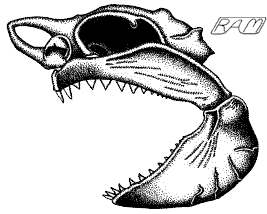Swimming Muscles and Kinetic Jaws
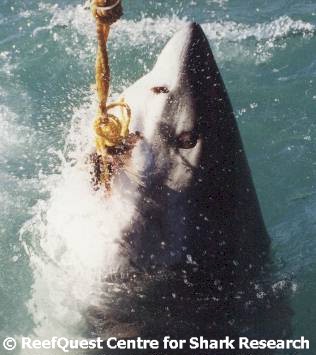 All the foregoing skeletal elements would compose a complex and
grotesque statue were it not for muscles to animate them. Muscles
transform the cartilaginous architecture of a shark into fluid, graceful
art. Perhaps in part because it is so difficult to move through water
efficiently, sharks are very muscular animals. Something on the order of
85% of a 'typical' shark's body weight is muscle, compared with about 35
to 45% for humans. Just as in humans (and holiday turkeys), sharks have
two basic types of muscle, red and white. Red muscle is relatively
slow-contracting and requires an oxygen-rich operating environment, but
has tremendous stamina. White muscle is relatively fast-contracting, does
not require an oxygen-rich environment, but tends to become exhausted
rather quickly due to the build-up of lactic acid (a somewhat toxic
cellular waste product). While white muscle comprises only a tiny
percentage of human muscle, over 90% of a shark's muscle mass is composed
of white muscle. As described earlier (in the section on body form and
swimming style), the Great White and other lamnid sharks have - to various
extents - augmented their swimming muscles with bands of red muscle along
their flanks. This adaptation probably grants the White Shark greater
swimming endurance than a shark whose swimming muscles are entirely
composed of white muscle.
All the foregoing skeletal elements would compose a complex and
grotesque statue were it not for muscles to animate them. Muscles
transform the cartilaginous architecture of a shark into fluid, graceful
art. Perhaps in part because it is so difficult to move through water
efficiently, sharks are very muscular animals. Something on the order of
85% of a 'typical' shark's body weight is muscle, compared with about 35
to 45% for humans. Just as in humans (and holiday turkeys), sharks have
two basic types of muscle, red and white. Red muscle is relatively
slow-contracting and requires an oxygen-rich operating environment, but
has tremendous stamina. White muscle is relatively fast-contracting, does
not require an oxygen-rich environment, but tends to become exhausted
rather quickly due to the build-up of lactic acid (a somewhat toxic
cellular waste product). While white muscle comprises only a tiny
percentage of human muscle, over 90% of a shark's muscle mass is composed
of white muscle. As described earlier (in the section on body form and
swimming style), the Great White and other lamnid sharks have - to various
extents - augmented their swimming muscles with bands of red muscle along
their flanks. This adaptation probably grants the White Shark greater
swimming endurance than a shark whose swimming muscles are entirely
composed of white muscle.
Shark swimming muscles, like those of most fishes, are composed of W-shaped blocks called "myotomes". These myotomes interdigitate in complex ways, with some parts of an individual muscle block extending forward and others back to form a series of intermeshing cones. This generates a body wave that propegates smoothly and sinuously along the body and - with the addition of a caudal fin - produces the vast majority of a shark's propulsive force. In cross section, shark swimming muscles form bundles of concentric rings that meet at the midline of the body underneath the lateral line (a vibration-detecting sensory system that extends along the flanks of fishes). Those muscle bundles above the lateral line are termed "epaxial" (back), those below "hypaxial" (flank). The arrangement of muscle fibers in a shark is quite different from that in a teleost. Whereas in a bony fish, muscle fibers tend to loop back on themselves, in sharks the muscle fibers attach to tough longitudinal struts composed of connective tissue. These struts may act as an auxiliary muscle attachment point along the flanks, compensating for sharks' lack of ribs.
Other muscles control sharks' fins, raising, lowering and flexing these foils to control every aspect of swimming. In conditions under which it is difficult to breathe, some sharks flare or rhythmically pump their gill slits to move oxygen-bearing water over their gill membranes. The White Shark may flare its gill muscles to facilitate oxygen-uptake when its mouth is temporarily 'plugged' with food prior to swallowing. Yet other muscles control the throat. Many sharks - such as the Nurse (Ginglymostoma cirratum), wobbegongs (family Orectolobidae), and angel sharks (Squatinidae) - can create powerful pharyngeal suction by rapidly expanding their muscular throats. The Great White can also create such a pharyngeal suction, though rather more weakly than in some sharks. Although young White Sharks may rely on this strategy to hoover up small fishes, when older and larger, this species tends to employ a more dramatic approach to grasping and dismembering large prey.
|
|
The jaws of the Great White Shark are among the most famous on the planet. The reasons why are not hard to fathom. By now, we've all seen them: those awesome, slow motion images of White Sharks being fed huge, bloody hunks of tuna or horsemeat at the surface. It is as hard to not be impressed by the shark's large, prominent teeth as it is difficult to resist the frightening thought of what such jaws could do to us, if they ever got the chance. In watching these gastronomic feats on television, many people have been struck by a vague sense that there is something decidedly odd about the way the White Shark's jaws seem to shoot out toward the bait, hover there for a moment or two, then retreat back into the head. Over and over we've seen this awesome dental dance - often enough to be reasonably sure that we are seeing what we think we're seeing. But very few of us appreciate exactly how this neat trick is achieved.
To study the jaw-protruding talents of the White Shark, ichthyologists Tim Tricas and John McCosker traveled to Dangerous Reef, South Australia. By analyzing the high-speed film of this species feeding - shot by veteran underwater cinematographer Al Giddings - Tricas and McCosker were able to study in minute detail the dental gymnastics of the 'White Pointer' (as the White Shark is widely known locally). In a paper published in 1984, they reported their findings. Tricas and McCosker found that each bite event - everything the Great White does seems to be an 'event' - consists of a uniform sequence of jaw and head movements. Tricas and McCosker divided this sequence into five components:
| 1. snout lift, 2. lower jaw opening, 3. palatoquadrate protrusion, 4. lower jaw closing, and 5. snout drop. |
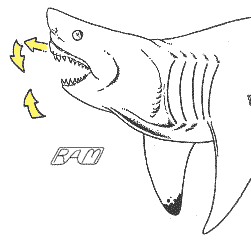 |
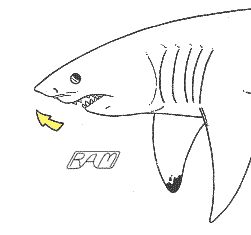
|
|
Component 3 in bite event of a White Shark, in which the upper jaw (palatoquadrate) is thrust forward and down as the lower jaw (mandible) begins to close. Arrows indicate jaw movements. |
Components 4 and 5 in bite event of a White Shark, in which the lower jaw (mandible) closes and the snout drops downward. Arrow indicates upper jaw (palatoquadrate) movement. |
Further, they found that for an 11.5-foot (3.5-metre) individual, the duration of a complete bite sequence ranged from 0.75 to 1.71 seconds, averaging about 0.99 seconds). In a separate paper published a year later, Tricas analyzed to what extent these bite events were stereotyped (performed the same way each time). He found that the sequence of components was highly stereotyped (based on both his data and through non-quantitative analyses of films of White Shark feeding taken by others at various times and places), but that the duration of bite events varied considerably. Tricas concluded that the White Shark bite sequence he and McCosker described is probably typical of the species and that variations in an individual shark's motivational state (degree of hunger, intimidation by proximity of researchers, etc.) may change the timing of bite components.
The sequence of a White Shark bite therefore seems to be highly choreographed. But, as before, what's going on beneath the shark's skin is where the real 'action' is. In an important pair of papers published in 1972 and 1977, shark biologist Sanford Moss studied the structure and evolutionary development of whaler shark (family Carcharhinidae) feeding mechanisms. By dissecting fresh and preserved specimens, as well as using an electrified probe to artificially stimulate muscle contraction in dead sharks, Moss clarified many aspects of how sharks employ their loosely slung jaws to produce a powerful bite. Moss reasoned that shark jaws are essentially a type of lever in which the force (provided by the jaw-closing, muscles) is positioned between the fulcrum (articulation between upper and lower jaws) and the load (object being bitten). Therefore, shorter jaws and thicker adductor muscles would be expected to produce a more powerful bite than longer jaws with thinner muscle. Indeed, if one examines the shark fossil record - such as it is - there seems to be a steady trend toward shorter and more thickly-muscled jaws.
In his 1972 paper, Moss found that the principal jaw-closing muscle in carcharhinid sharks - and, by extension, Great Whites - is a large mass composed of four discrete but intimately associated muscles at the rear of the jaws. Further, through his dissections and myoelectric experiments, Moss found that the palatoquadrate is pulled forward by two separate muscles acting in concert. As the palatoquadrate is protruded, it rides forward and down in a groove in the anterior part of the skull, to a limit imposed by the ligaments which attach to cartilaginous processes on either side the palatoquadrate. As the jaws are protruded, Moss discovered that yet two other muscles rotate the hyoid arch forward, to buttress the displaced jaws from behind. For all this anatomical sophistication, it was not until Tricas and McCosker's analysis of high-speed images of feeding White Sharks that we could see how all these muscles, jaw and head components worked together to create a spectacularly powerful bite.
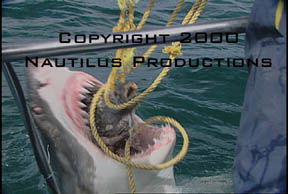 As a White Shark approaches the bait, its conical snout raises, forming
an angle of 30 to 40 degrees above the body's long axis. Very quickly,
within about 14/100ths of a second, the lower jaw gapes wide open. At this
point a strange and wonderful transformation occurs: in 2 or 3 tenths of a
second, the palatoquadrate is pulled forward and down, gliding along a
groove on the underside of the skull. As the palatoquadrate is protruded
and the gape is increased, the jaws widen and the the hyoid arch rotates
forward to brace the jaws from behind. As the shark's relatively narrow
lower jaw teeth stab into the food item, its eyes roll tailward in their
sockets (exposing the tough, white scleratic coat) to protect them from
injury. At the same time, the shark's broadly triangular upper teeth reach
the surface of the food and its pectoral fins curl forward, bracing the
body in the water column. The jaws smash together with unimaginable force,
clamping onto a gobbet of flesh. The shark then begins thrashing its head
violently from side-to-side, maximizing the cutting efficiency of its
serrated upper teeth. As the jaws are retracted - and almost as an
afterthought - the feeding bout ends with the snout dropping back to its
original position. What makes this all truly amazing is that less than two
seconds has elapsed and as much as 50 pounds (23 kilograms) of meat are
gone - all as easily as you or I might bite an over-ripe peach.
As a White Shark approaches the bait, its conical snout raises, forming
an angle of 30 to 40 degrees above the body's long axis. Very quickly,
within about 14/100ths of a second, the lower jaw gapes wide open. At this
point a strange and wonderful transformation occurs: in 2 or 3 tenths of a
second, the palatoquadrate is pulled forward and down, gliding along a
groove on the underside of the skull. As the palatoquadrate is protruded
and the gape is increased, the jaws widen and the the hyoid arch rotates
forward to brace the jaws from behind. As the shark's relatively narrow
lower jaw teeth stab into the food item, its eyes roll tailward in their
sockets (exposing the tough, white scleratic coat) to protect them from
injury. At the same time, the shark's broadly triangular upper teeth reach
the surface of the food and its pectoral fins curl forward, bracing the
body in the water column. The jaws smash together with unimaginable force,
clamping onto a gobbet of flesh. The shark then begins thrashing its head
violently from side-to-side, maximizing the cutting efficiency of its
serrated upper teeth. As the jaws are retracted - and almost as an
afterthought - the feeding bout ends with the snout dropping back to its
original position. What makes this all truly amazing is that less than two
seconds has elapsed and as much as 50 pounds (23 kilograms) of meat are
gone - all as easily as you or I might bite an over-ripe peach.
